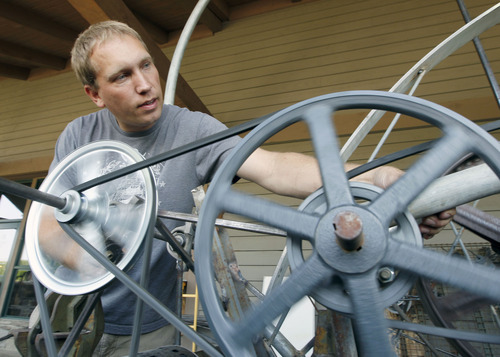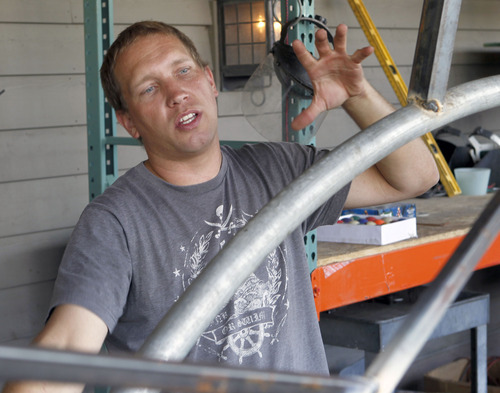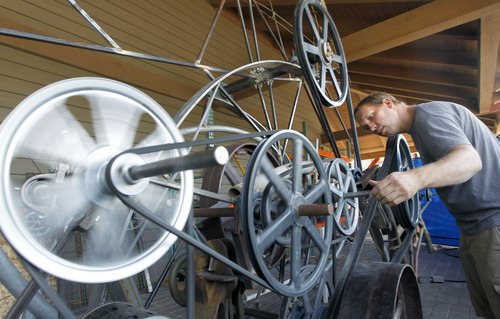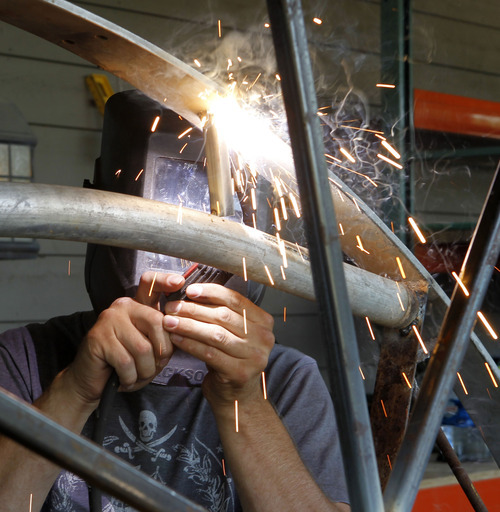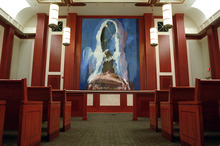This is an archived article that was published on sltrib.com in 2012, and information in the article may be outdated. It is provided only for personal research purposes and may not be reprinted.
Most people don't think about the art placed in and around public buildings. "I don't know if people realize it's there," said Valerie Price, public-art program manager for Salt Lake County, "and it's always there."
A prime reason art exists in Utah's government buildings is the Public Art Program, created by the Utah Legislature in 1985 to set aside 1 percent of the budget of any major public building for site-specific artwork.
An exhibit mounted by the Utah Division Arts and Museums — on display now through Friday, Sept. 14, at the Rio Grande Depot, 300 S. Rio Grande, Salt Lake City — celebrates the state's Public Art Program, with photos and artists' designs from 25 of the 107 artworks created under the program.
Public art isn't "just a black hole where money goes and nobody sees any benefit," said Jim Glenn, manager of the state's public art, design arts and fine arts collections – and the curator of the Rio Grande exhibit. There are intangible benefits, "like quality of life."
Other benefits are tangible. "You have people who are proud to live in a place that talks about their community," Glenn said. "That attracts businesses willing to locate here. That in turn drives the economy of the creative community. It's all tied in."
At the state level, any significant public building — that is, any building owned by the state of Utah where the public is invited — has 1 percent of its budget set aside for public art. That set-aside is mandatory, Glenn said, though the Legislature's budget subcommittees have the authority to remove that money from the budget.
Deciding what art goes into a space, like any government contract, can get complicated. Each project is selected by a committee, Glenn said, made up of members of the community — people who live in the area, as well as employees of the agency that will call the building their workplace. This ensures that the art speaks to community needs and is representative of what happens in the building.
Glenn points to what he considers one successful recent piece, newly installed at Dixie State College's new library and commons in St. George.
Christian Moeller's artwork is a massive bookcase, 28 feet wide and 22 feet high, packed with books whose bindings are white and various shades of blue.
Seen from a distance, the books' spines become pixels in a giant picture of a cloud — symbolic of the digital "cloud" of information. The pages of the books are blank and can be checked out as journals, harking back to the writing traditions of the state's first settlers.
Even with the involvement of those who work near the art, controversy can arise. A famous case was Douglas Snow's 1997 massive abstract painting "Capitol Reef," installed behind the bench of the Utah Supreme Court. The work turned out to be too much for the room, dwarfing the justices and distracting people in the courtroom. Eventually, a curtain was installed to hide the painting during court sessions — though the painting is visible at other times.
Salt Lake City and Salt Lake County have similar "1 percent for art" programs, but with one key difference: The programs aren't mandatory, as they are in some U.S. cities.
Usually, that distinction isn't important. According to Price, every major public building in downtown Salt Lake City — whether run by the city, county, state or federal government — has some art component.
The instances of a governing body cutting the public-art budget are rare. It happened this spring, when the Salt Lake County Council, faced with a construction budget $12 million more than expected, voted to remove $217,000 to be spent on public art for a new headquarters for the district attorney. "It was sticker shock," Price said.
It also became a moot point. In June, when the County Council was told the DA's building would cost even more millions, the council voted to scrap the building plan and start over.
In July, Salt Lake City announced what will become the city's newest public art: the four works to grace the new Public Safety Building.
The projects include giant bronze hands, in the American Sign Language symbol for "to serve," by Park City sculptor Greg Ragland; an interactive water feature; an atrium display of colorful translucent arcs; and an interactive sculpture incorporating the silhouettes of the building's many employees.
"The building itself is pretty spectacular," said Roni Thomas, public-art program manager for the Salt Lake City Arts Council, which was responsible for the art selection process. "[The art has] to be in that building and speak to who is in the building."
Public art enhances the urban environment, Thomas said. "It makes us a more cosmopolitan city," she said. "It's a chance to showcase local artists, and it gives tourists and seasonal residents a chance to learn more about our culture."
And public art can be considered a quality-of-life issue. "You want to enjoy being in a space," Glenn said. "You want to be there. You want to be proud of where you are."
spmeans@sltrib.comTwitter: @moviecricketwww.facebook.com/seanpmeans



